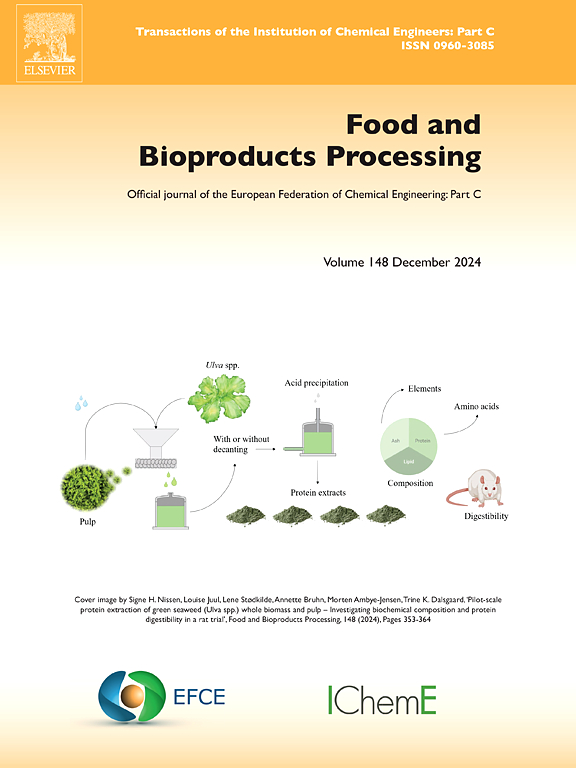Transcriptomic combined with molecular dynamics simulation analysis of the inhibitory mechanism of clove essential oil against Staphylococcus aureus biofilm and its application on surface of food contact materials
IF 3.5
2区 农林科学
Q2 BIOTECHNOLOGY & APPLIED MICROBIOLOGY
引用次数: 0
Abstract
Staphylococcus aureus (S. aureus) can easily generate biofilm on food processing equipment surface, thus increasing the risk of food contamination. Clove essential oil (CEO) has been extensively utilized in food industry due to its safety and effectiveness against S. aureus biofilm. The current study aimed to reveal the activity of CEO against S. aureus biofilm and explore its potential molecular mechanism. The results indicated that CEO had significant inhibition effect on S. aureus biofilm. Electron microscope observation indicated that CEO could inhibit extracellular polymeric substances (EPS) and damage the 3-dimensional structure of biofilm. Based on transcriptomic and molecular dynamics simulation, it was found that eugenol (principal component of CEO) was highly enriched on the phospholipid bilayer, which in turn affects various biological processes of bacteria, such as metabolism, biofilm formation and quorum sensing. Meanwhile, according to significant difference analysis, eugenol mainly down-regulated the transcription levels of EPS synthesis-related genes (ica operon and cidA) to inhibit biofilm formation, followed by quorum sensing-related genes (agrA, agrB and agrC), sarA and sigB. Finally, a challenge test indicated that CEO with MBIC concentration could decrease the number of S. aureus on food contact surface by 103–4 orders of magnitude. Therefore, CEO could be a potential natural anti-biofilm material to combat S. aureus biofilm and guard food safety.
丁香精油对金黄色葡萄球菌生物膜抑制机制的转录组学结合分子动力学模拟分析及其在食品接触材料表面的应用
金黄色葡萄球菌(S. aureus)很容易在食品加工设备表面生成生物膜,从而增加了食品污染的风险。丁香精油因其抗金黄色葡萄球菌生物膜的安全性和有效性在食品工业中得到了广泛的应用。本研究旨在揭示CEO对金黄色葡萄球菌生物膜的活性,并探讨其潜在的分子机制。结果表明,CEO对金黄色葡萄球菌生物膜有明显的抑制作用。电镜观察表明,CEO能抑制胞外聚合物(EPS),破坏生物膜的三维结构。基于转录组学和分子动力学模拟,发现丁香酚(CEO的主要成分)在磷脂双分子层上高度富集,进而影响细菌的代谢、生物膜形成和群体感应等多种生物过程。同时,通过显著差异分析,丁香酚主要下调EPS合成相关基因(ica operon和cidA)的转录水平来抑制生物膜的形成,其次是群体感应相关基因(agrA、agrB和agrC)、sarA和sigB。最后,攻毒试验表明,添加MBIC浓度的CEO可使食品接触表面的金黄色葡萄球菌数量减少103-4个数量级。因此,CEO可能是一种潜在的天然抗生物膜材料,可以对抗金黄色葡萄球菌生物膜,保护食品安全。
本文章由计算机程序翻译,如有差异,请以英文原文为准。
求助全文
约1分钟内获得全文
求助全文
来源期刊

Food and Bioproducts Processing
工程技术-工程:化工
CiteScore
9.70
自引率
4.30%
发文量
115
审稿时长
24 days
期刊介绍:
Official Journal of the European Federation of Chemical Engineering:
Part C
FBP aims to be the principal international journal for publication of high quality, original papers in the branches of engineering and science dedicated to the safe processing of biological products. It is the only journal to exploit the synergy between biotechnology, bioprocessing and food engineering.
Papers showing how research results can be used in engineering design, and accounts of experimental or theoretical research work bringing new perspectives to established principles, highlighting unsolved problems or indicating directions for future research, are particularly welcome. Contributions that deal with new developments in equipment or processes and that can be given quantitative expression are encouraged. The journal is especially interested in papers that extend the boundaries of food and bioproducts processing.
The journal has a strong emphasis on the interface between engineering and food or bioproducts. Papers that are not likely to be published are those:
• Primarily concerned with food formulation
• That use experimental design techniques to obtain response surfaces but gain little insight from them
• That are empirical and ignore established mechanistic models, e.g., empirical drying curves
• That are primarily concerned about sensory evaluation and colour
• Concern the extraction, encapsulation and/or antioxidant activity of a specific biological material without providing insight that could be applied to a similar but different material,
• Containing only chemical analyses of biological materials.
 求助内容:
求助内容: 应助结果提醒方式:
应助结果提醒方式:


